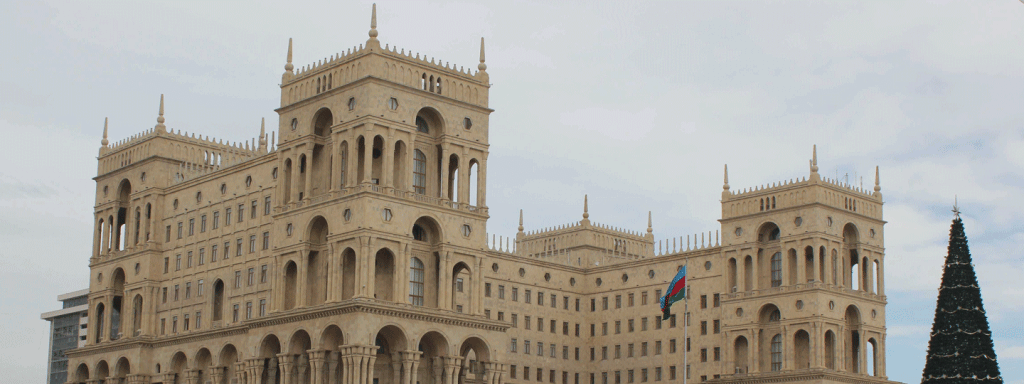Politics – 19th Century Politics

19th CENTURY POLITICS
Azerbaijani Rule In The 19th Century
In the mid-eighteenth century, the country was split into 20 Azerbaijani Khanates. The Persian, Russian and Ottoman Empires remained in conflict. Each wanted to take advantage of their own favourable geopolitical position. The Russo-Persian War (1804-1813) and Russo-Persian War (1826-1828), helped force the cession and loss of what is nowadays’ Georgia, Dagestan, Armenia, and Azerbaijan to Imperial Russia. This was arranged through the Gulistan and Turkmenchay Treaties of 1813 and 1828.
Treaty of Gulistan
In 1812 Russia ended a war with Turkey and went on the offensive against Iran. This led to the treaty of Gulistan. The British assisted the Iranians with the matter, but the fact remained that Russian troops had marched as far as south as Tabriz. Although certain areas (including Tabriz) were returned to Iran, Russia was in fact at the peak of its territorial expansion.
Following their defeat by Russia, Qajar Iran was thus forced to sign the Treaty of Gulisten in 1813, which acknowledged the loss of Dagestan, Georgia and most of Azerbaijanian territory to Russia. Local khanates were either abolished (like in Baku or Ganja) or accepted Russian patronage.
Treaty of Turkmenchay
The Russians dictated another infamous final settlement as per the Treaty of Turkmenchay, which resulted in the Qajars of Persia ceding their last remaining Caucasian territories in 1828, comprising the last parts of the modern day Azerbaijani Republic as well as modern-day Armenia. The treaty established the current borders of Azerbaijan and Iran as the rule of local khans ended completely.
Russian Control
In the newly Russian-controlled territories, two provinces were established that later constituted the bulk of the modern Azerbaijani Republic: the Ganja province in the west, and Shamakha province in the east. At the beginning of Russian administration, the Tsars did not significantly interfere with local affairs and the migration of the Christian population into Azerbaijan was minimal. As a result of a catastrophic earthquake in 1858, the capital of the eastern province was transferred from Shamakha to Baku which attained greater importance over time.
Discovery of Petroleum
The discovery and exploitation of petroleum in the 1870s led to a period of unprecedented prosperity and growth in the years prior to World War I. However, it also created huge disparities in wealth between the largely European capitalists and the local Muslim work force. By 1900, the population of Baku increased from 10,000 to roughly 250,000 people as a result of worker migration from all over the Empire, Iran, and other places.
Growth of Baku and the middle-class
The growth of Baku and the progression of an exploitative economy resulted in the emergence of an Azerbaijani nationalist intelligentsia that was educated and influenced by European and Ottoman ideas. Influential thinkers like Hasan bey Zardabi and Mirza Fatali Akhundov spurred a nationalist discourse and also rallied against poverty, ignorance, extremism and sought reforms in education and the emancipation of the dispossessed classes, including women. The financial support of philanthropist millionaires also bolstered the rise of an Azerbaijani middle-class.
After decades of stagnation the extraction of oil began to gain momentum. The impact of Russian control was a more mechanised process of oil drilling and the Azerbaijani control of oil was opened up to long term leases to drill owners. As a result of these reforms, in 1870’s Baku went experienced the inflow of industry and new revenue. This became a major boom city and introduced new forms of transportation and infrastructure.
With the expansion of the oil industry, Baku grew into a thorough urban centre in which no particular ethnic group was predominant. The three largest population groups within Baku could be decided as the Russians, the Armenians and the Muslims.
Beginnings of Ethnic Riots
Following the disastrous Russo-Japanese War, an economic and political crisis erupted in Baku. This began with a general strike of oil workers in 1904. By 1905, class and ethnic tensions resulted in Muslim-Armenian ethnic rioting. During the first Russian Revolution The Tsarist governments had, in fact, exploited ethnic and religious strife to maintain control in a policy of divide and rule, so this was not disconnected.

Early 20th Century Class & Ethnic Tensions
At the time of Tsarist Russia it was uncommon that class tensions were recorded due to the ideology of the Communist society. However the propaganda that there was not more than one class in society or religion(s) within The Russian Federation was an ideal that was not wholly true, especially in the Caucasus region.
Immigrant Workers
The changes that came for ‘Oil Boom Baku’ allowed an import of investment and an uplift of local economy. It also led to an import of foreign workers and an uplift of positions for local Bakuvians. Workers came from as far as Germany, Finland, the Russian provinces, Latvia, Armenia, Iran and Poland.
The Nobel Brothers Oil Company uniquely recorded information about its employees at the time. These records illustrate how this sudden culture assimilation was being forced and also how this was managed by the companies.
The records show firstly and importantly, that there was a mix of ethnicities and religions working at company. Secondly, that unrest between workers was at first not a problem. All Religious holidays were catered for at the plant, for a mix of majority Muslim and Christian and minority Jewish workers.
Workers Protests and Conflict
Protests had been recorded within the company, but not directly for ethnic tension reasons. Rather, there was a campaign for the extension of daily prayer hours for Muslim workers from 5 to 15 minutes. Another repeated request was that all workers would be given the same standard of housing.
Secondly it showed that unfortunately a number of employees were killed in the riots and protests of 1905. This brings indicates that the tolerance of individual ethnicity and culture in Baku was not the cause of the riots. Rather that the riots can be contributed to the way ethnicity was used to separate and repress the masses.
It was recorded that separation of jobs and wages in the factories were based on variation of skilled work. With a large amount of more well educated foreign workers coming from provinces in Russia, local Azerbaijani people were left with dirtier and less skilled and less well paid jobs. Many of the notices of rules and payments and opportunities within employment were written notices as opposed to being vocalised. As such, the less educated workers (who again,were majority local and Muslim) were not communicated to efficiently.
This structure of segregation was made worse by the ideology of a classless system. This created obvious polarisations between the proletariat. Within Baku, Religion and Ethnicity could easily correlate and those without wealth were rarely politically listened to. Neither was the accumulated wealth of the factories being invested in the local population’s advancement.
Legacy of Tensions
The situation improved during 1906–1914, when a limited parliamentary system was introduced in Russia. Muslim MPs from Azerbaijan were able to actively promote Azerbaijani interests.
After Russia became involved in World War I, social and economic tensions spiked again. The Russian Revolution ultimately led to the granting of rights and self -rule to the local population of Azerbaijan. However, this autonomy also led to renewed ethnic conflict between Azerbaijanis and Armenians. See our History Pages for more information
For further information, please read ‘Ethnic relations during the first oil boom’ by Parvin Ahanchi, Leading research fellow of Azerbaijan National Academy of Sciences:
http://biweekly.ada.edu.az/vol_4_no_4/Ethnic_relations_in_Baku_during_the_first_oil_boom.html
Oil Magnates
Some of the first innovations in oil refining, output and carrying areas were realised in Azerbaijan. It was also one of the most tolerant oil trade countries, due to foreign capitalist attention to this region.
At the end of the 19th and early 20th centuries approximately twenty foreign companies operated in Azerbaijan. One of the companies belonging to the infamous “Nobel Brothers”. The Nobel brothers established the first foreign company in the capital of Azerbaijan, Baku. “The Nobel Brothers” firm had continued its trade generally in the course of 47 years in Azerbaijan. The firm had commissioned 25-28 % of the total volume of oil produced in Baku. The firm paid special attention to commerce, as well as the development of science. Notably, they also increased employees’ financial maintenance and improved the education of them and their children.

